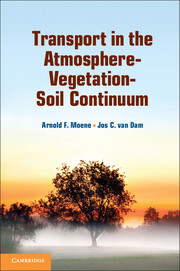Book contents
- Frontmatter
- Contents
- Preface
- 1 The Atmosphere-Vegetation-Soil System
- 2 Available Energy: Net Radiation and Soil Heat Flux
- 3 Turbulent Transport in the Atmospheric Surface Layer
- 4 Soil Water Flow
- 5 Solute Transport in Soil
- 6 Vegetation: Transport Processes Inside and Outside of Plants
- 7 Combination Methods for Turbulent Fluxes
- 8 Integrated Applications
- 9 Integrated Models in Hydrology and Meteorology
- Appendix A Radiation
- Appendix B Thermodynamics and Water Vapour
- Appendix C Dimensional Analysis
- Appendix D Microscopic Root Water Uptake
- Appendix E Crop Factors for Use with Makkink Reference Evapotranspiration
- Answers
- List of Main Symbols
- References
- Index
9 - Integrated Models in Hydrology and Meteorology
Published online by Cambridge University Press: 05 June 2014
- Frontmatter
- Contents
- Preface
- 1 The Atmosphere-Vegetation-Soil System
- 2 Available Energy: Net Radiation and Soil Heat Flux
- 3 Turbulent Transport in the Atmospheric Surface Layer
- 4 Soil Water Flow
- 5 Solute Transport in Soil
- 6 Vegetation: Transport Processes Inside and Outside of Plants
- 7 Combination Methods for Turbulent Fluxes
- 8 Integrated Applications
- 9 Integrated Models in Hydrology and Meteorology
- Appendix A Radiation
- Appendix B Thermodynamics and Water Vapour
- Appendix C Dimensional Analysis
- Appendix D Microscopic Root Water Uptake
- Appendix E Crop Factors for Use with Makkink Reference Evapotranspiration
- Answers
- List of Main Symbols
- References
- Index
Summary
This chapter shows how the methods discussed in the previous chapters are applied in hydrological and meteorological models. The SWAP (Soil, Water, Atmosphere, Plant) model is an example of a field-scale ecohydrological model (Section 9.1). In Section 9.2 various aspects of land–surface models as used in weather and climate models are discussed.
Introduction
SWAP simulates transport of water, solutes and heat in the vadose zone (Kroes et al., 2008; Van Dam et al., 2008). The model includes vegetation growth, as affected by meteorological and hydrological conditions. The upper boundary of the model domain is a plane just above the canopy. The lower boundary corresponds to a plane in the shallow groundwater (Figure 9.1). In this model domain the transport processes are predominantly vertical; therefore SWAP is a one-dimensional, vertical directed model. The flow below the groundwater level may include lateral drainage fluxes, provided that these fluxes can be prescribed with analytical drainage formulas. The model is very flexible with regard to input data at the upper and lower boundaries. At the top general data on rainfall, irrigation and evapotranspiration are used. For frost conditions a simple snow storage module has been implemented and soil water flow will be impeded when soil temperature descends below zero. To facilitate temporal detailed studies on surface runoff and diurnal transpiration fluxes, evapotranspiration and rainfall data can be specified at daily and shorter time intervals. At the model lower boundary, various forms of head and flux based conditions are used.
- Type
- Chapter
- Information
- Transport in the Atmosphere-Vegetation-Soil Continuum , pp. 302 - 344Publisher: Cambridge University PressPrint publication year: 2014



